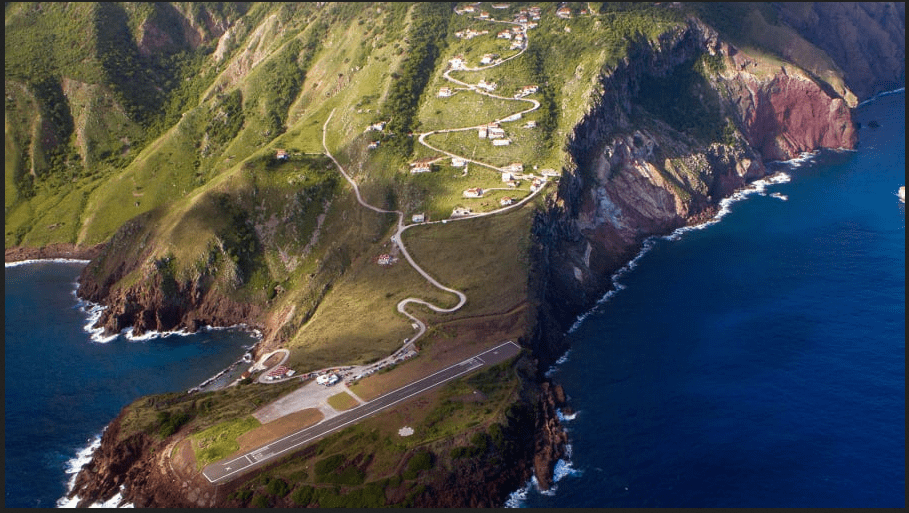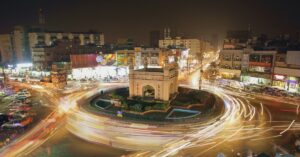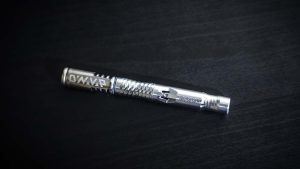Flying into Saba is not something for the faint of heart. The vertical slopes and tall cliffs of this five-square-mile island in the Caribbean are not only dangerous to pilots, but also prevent them from touching back down on their landing gear. However, Juancho E. Yrausquin Airport offers an inspiring view of the island and a solvable dilemma: its only flat piece of land.
The Juancho E. Yrausquin Airport on the Caribbean island of Saba is the world’s shortest commercial runway at only 1,300 feet (about 400 meters), 900 feet of which are usable. Sheer drops into the sea at either end add an extra layer of excitement to the arrival on what is acknowledged as being the shortest commercial runway in the world. Juancho E. Yrausquin Airport is something of a holy grail for avgeeks, but it is also a lifeline for Saba, bringing in tourists and taking out locals in need of medical attention. The runway appears on one of Saba’s postage stamps, and the souvenir shop in the village of Windwardside sells T-shirts emblazoned with the slogan, “I survived the Saba landing!” You could take the ferry to get here, but many people prefer flying because it is often listed as one of “the world’s scariest landings.”
An exclusive class of pilot
The 15-minute departures from Sint Maarten are on 19-seater de Havilland Canada DHC-6 Twin Otters, STOL (short departure and landing) utility airplane intended to serve testing air terminals and stop rapidly, a benefit that ends up being clear once the wheels contact down on Saba.
It takes a tip top gathering of uncommonly prepared pilots to fly into the island, with Sint Maarten-based Winair the main carrier working booked trips in and out.
Veteran pilot Captain Roger Hodge is Winair’s Twin Otter armada educator, and has prepared all of them. “When a person has been completely prepared and we’re fulfilled, we radio into tasks that another Top Gun is conceived. That is the very thing that we call them,” he says.
Prior to loading up, I request that him what expect on the 15-minute flight. “May the Lord accompany you,” he says gravely, prior to chuckling and letting me know that I will appreciate it, and to sit on the option to see the wings brush the mountainside on conclusive methodology. As of now I feel my heart thumping quicker.
“Flying into Saba gets sort of furry here and there, yet by knowing what to do, we make it look basic and quiet,” says Hodge.
Those furry circumstances include the standard flight crisis situations like motor disappointment on approach, however there are different contemplations because of the brevity of the runway and its descending slant. There are weight and wind speed impediments, as well. The equivalent goes for downpour. Assuming the runway is wet, nobody is flying in. On a runway this short, there’s no wiggle room.
“As a pilot I simply love going into Saba since that is the point at which you set your experience to work,” he says. “There’s generally adrenaline that kicks in on the grounds that you’re being watched by travelers and individuals on the ground, yet you’ve quite recently got to fly that machine.”
An ethereal experience
Regardless of the looming fervor, boarding at Sint Maarten’s Princess Juliana International Airport is a genuinely loosened up undertaking.
There’s no relegated seating so flight fans searching for a pilot’s eye view ought to crush in first to grab a tough situation – – 1B – – right at the front in the center. With no entryway isolating the cockpit from the lodge, it resembles sitting between the Captain and the First Officer.
Sint Maarten’s green mountains, brilliant sea shores and turquoise waters make for a grand flight, yet there’s very little chance to pause for a minute and partake in the perspectives. After departure, flight WM441 flies in an orderly fashion towards Saba, the island’s outline noticeable not too far off only 24 miles away. There’s consistent movement in the cockpit, flicking of switches and winding of handles and dials, with the two pilots working in amazing coordination.
As the miles rapidly fall away, the island lingers consistently nearer. Also, closer. It’s unbelievably lovely yet additionally bump in-the-throat stuff, and there’s a second when maybe you’re going directly toward the volcanic slants.
In any case, at the last possible moment, the plane makes a sharp lean toward the left toward the runway which, until this point, has been imperceptible. Travelers on the right-hand side have close-up perspectives on the ocean precipices. Travelers on the left gaze directly down into the water.
As the plane levels out for conclusive methodology the wing basically skims the slope, yet the airplane comes in low and smooth and lands with a squeak of elastic, an immense impact of converse push, and a short taxi to the furthest limit of the runway where the people who actually have their eyes open can peer down into the water underneath.
Unnerving? Indeed. Worth the effort? Without a doubt.
Rescuing the island once again from disengagement
The main pilot to arrive on Saba probably had a much seriously thrilling experience.
Aggressive pilot Rémy de Haenen from the adjoining island of St Barthélemy made the island’s most memorable arriving in 1959. Numerous close by islands previously had airstrips worked during World War II, yet Saba’s lofty sides and absence of level ground were thought of as unacceptable.
In any case, de Haenen tested the thought, looking over the geology and ultimately recognizing the appropriately named Flat Point as the most encouraging site for his endeavor to steer the initial trip into Saba.
Saban antiquarian Will Johnson’s dad used to cultivate Flat Point on ground possessed by his granddad. “My dad allowed to get out the land, and he probably figured that in the event that the endeavor didn’t succeed, every one of the stones would be gone,” he says.
A previous island chief, representative and distributer of the Saba Herald paper for a long time, Johnson’s information on the island is comprehensive. He says that when the choice had been made to check it out, inside a long time and with little hardware other than “a couple of push carts,” the land had been cleared and straightened, prepared for the endeavored landing.
A lot of individuals on the island actually recollect de Haenen handling his Dornier Do-27 on the recently gotten stretch free from land on February 9, 1959. “Everyone emerged, endlessly hordes of individuals. It was astonishing,” says James Franklin Johnson, a mountain guide for the Saba Conservation Foundation who was eight years of age at that point. “Saba emerged from disengagement when the plane arrived on the island.”
In any case, de Haenen’s arrival didn’t touch off a quick whirlwind of aeronautics action. He was prohibited from rehashing his arrival because of wellbeing issues, and it was only after 1963 that Saba had its own completely working air terminal.
A last eruption of adrenaline
A large portion of Saba’s flight publicity spins around the arrival, however the island saves a last eruption of adrenaline for those withdrawing via air. The inventively named fundamental street, The Road, offers the ideal vantage point for perspectives on the air terminal, and the valiant might need to watch a flight taking off before their own takeoff. The plane purposes the whole length of the runway, at the last possible moment taking off when there’s essentially no ground left.
Beginning from the end, the plane rates down the runway, coming increasingly close to the end, and briefly it appears to drop off towards the water, before a whoosh impels the plane – – and its extremely feeling better travelers – – skywards.
It very well might be a praiseworthy symbol to say you’ve endure the Saba arrival, yet the adventure of the take-off from Juancho E. Yrausquin air terminal merits its own spot on the planet’s most startling rankings.








